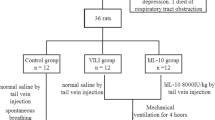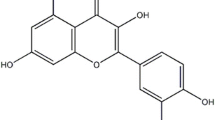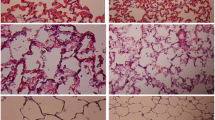Abstract
Rats injected with interleukin-1 (10 μg) and tumor necrosis factor (10 μg) and then exposed continuously to hyperoxia (> 99% O2, 1 atm) survived longer, had increased lung reduced/oxidized glutathione ratios, smaller pleural effusions, less pulmonary hypertension and improv+++ed arterial blood gases. The percentage of animals surviving for 72 hours in hyperoxia increased from 8% to 94%. Although relatively small increases in glutathione redox cycle enzymes occurred four and sixteen hours following cytokine injection, dramatic increases in all major antioxidant enzymes including superoxide dismutase, glucose-6-phosphate dehydrogenase, glutathione reductase, glutathione peroxidase, and catalase had occurred following 72 hours of exposure to hyperoxia. The protective effect of IL-1 + TNF against lethal pulmonary O2 toxicity could be partially inhibited by pre-injection of lysine acetylsalicylate or, less effectively, of ibuprofen.
Recent studies have suggested that both IL-1 and TNF can induce manganese (mitochondrial) superoxide dismutase mRNA and protein synthesis in a variety of cell types. Preliminary studies suggest that IL-1 alone, in ample dosage, can provide protection against lethal pulmonary O2 toxicity. Future studies should be directed toward identification of acute phase changes in lung antioxidant enzymes, surfactant proteins and/or lipid components, enzymes needed for synthesis of surfactant phospholipids, and/or other protective proteins. Additional work also needs to be done in identifying the lung cell types in which early enzyme induction occurs. These studies should provide a better understanding of mechanisms whereby protection against pulmonary O2 toxicity can occur. An understanding of the molecular mechanisms inducing protective proteins should lead to more precise pharmacologic control of these processes.
Similar content being viewed by others
References
Frank L, Summerville J, Massaro D. Protection from oxygen toxicity with endotoxin. Role of the endogenous antioxidant enzymes of the lung. J Clin Invest 1980; 65: 1104–10.
Dinarello CA. Biology of interleukin 1. FASEB J 1988; 2: 108–15.
Beutler B, Cerami A. Cachectin: more than a tumor necrosis factor. N Engl J Med 1987; 316: 379–85.
White CW, Ghezzi P, Dinarello CA, Caldwell SA, McMurtry IF, Repine JE. Recombinant tumor necrosis factor and interleukin 1 pretreatment decreases lung oxidized glutathione accumulation, lung injury and mortality in rats exposed to hyperoxia. J Clin Invest 1987; 79: 1868–73.
White CW, Ghezzi P, McMahon S, Dinarello CA, Repine JE. Cytokines increase rat lung antioxidant enzymes during exposure to hyperoxia. J Appl Physiol 1989; 66: 1003–7.
Michie HR, Manogue KR, Spriggs DR, Revhaug A, O'Dwyer S, Dinarello CA, Cerami A, Wolff SM, Wilmore DW: Detection of circulating tumor necrosis factor after endotoxin administration. N Engl J Med 1988; 318: 1481–86.
Okusawa S, Gelfand JA, Ikejima T, Connoly RJ, Dinarello CA. Interleukin 1 induces a shock-like state in rabbits. Synergism with tumor necrosis factor and the effect of cyclooxygenase inhibition. J Clin Invest 1988; 81: 1162–72.
Wise WC, Cook JA, Eller T, Halushka PV. Ibuprofen improves survival from endotoxic shock in the rat. J Pharm Exp Ther 1980; 215: 160–4.
Snapper JR, Hutchison AA, Ogletree ML. Effects of cyclooxygenase inhibitors on the alterations in lung mechanics caused by endotoxemia in the unanesthetized sheep. J Clin Invest 1983; 72: 63–76.
Dinarello CA, Cannon JG, Mier JW, Bernheim HA, Lo-Preste G, Lynn DL, Love RN, Webb C, Auron PE, Reuben RC, Rich A, Wolff SM, Putney SD. Multiple biological activities of human recombinant interleukin 1. J Clin Invest 1986; 77: 1734–39.
Stanbrook HS, Morris KG, McMurtry IF. Prevention and reversal of hypoxic pulmonary hypertension by calcium antagonists. Am Rev Respir Dis 1984; 130: 81–85.
Adams JD, Jr, Lauterburg BH, Mitchell JR: Plasma glutathione and glutathione disulfide in the rat: regulation and response to oxidative stress. J Pharm Exp Ther 1984; 237: 749–54.
Crapo JD, McCord JM, Fridovich I. Preparation and assay of superoxide dismutases. Methods Enzymol 1978; 53: 382–93.
Beutler E. Red cell metabolism. A manual of biochemical methods. New York: Grune and Stratton, 1975.
Bergmeyer HU. Zur messung von katalase-aktivataten. Biochem Z 1955; 327: 255–8.
Villa S, de Gaetano G. Prostacyclin-like acitivity in rat vascular tissues. Fast, long-lasting inhibition by treatment with lysine acetylsalicylate. Prostaglandins 1977; 14: 1117–24.
Movat HZ, Burrowes CE, Cybulsky MI, Dinarello CA. Acute inflammation and a Schwartzman-like reaction induced by interleukin-1 and tumor necrosis factor. Synergistic action of the cytokines in the induction of inflammation and microvascular injury. Am J Pathol 1987; 129: 463–76.
Tsan M-F. Lung specific delivery of tumor necrosis factor protects against lethal hyperoxia. Clin Res 1989; 37: 483A (abstract).
Shiki Y, Meyrick BO, Brighan KL, Burr IM. Endotoxin increases superoxide dismutase in cultured bovine pulmonary endothelial cells. Am J Physiol 1987; 252: C436-C440.
Visner GA, Dougall WC, Wilson JM, Block ER, Burr IM, Nick HS. Regulation of manganese and copper zinc superoxide dismutase mRNA levels in pulmonary cells by endotoxin and oxygen. Am Rev Respir Dis 1989; 139(4): A368 (abstract).
Masuda A, Longo DL, Kobayashi Y, Appella E, Oppenheim JJ, Matsushima K. Induction of mitochondrial manganese superoxide dismutase by interleukin 1. FASEB J 1988; 2: 3087–91.
Wong GHW, Goeddel DV. Induction of manganous superoxide dismutase by tumor necrosis factor: possible protective mechanism. Science 1988; 242: 941–4.
Turrens JF, Crapo JD, Freeman BA. Protection against oxygen toxicity by intravenous injection of liposome entrapped catalase and superoxide dismutase. J Clin Invest 1984; 73: 879–85.
Freeman BA, Young SL, Crapo JD. Liposome-mediated augmentation of superoxide dismutase in endothelial cells prevents oxygen injury. J Biol Chem 1985; 258: 12534–42.
Beckman JS, Minor RL, Jr, White CW, Repine JE, Rosen GM, Freeman BA. Superoxide dismutase and catalase conjugated to polyethylene glycol increases endothelial enzyme activity and oxidant resistance. J Biol Chem 1988; 263: 6884–92.
Crapo JD, Berry BE, Foscue HA, Shelburne J. Structural and biochemical changes in rat lungs during exposures to lethal and adaptive doses of oxygen. Am Rev Respir Dis 1980; 122: 123–43.
White CW, Jackson JH, McMurtry IF, Repine JE. Hypoxia increases glutathione redox cycle and protects rat lungs against oxidants. J Appl Physiol 1988; 65: 2607–16.
Chang SW, Feddersen CO, Henson PM, Voelkel NF. Platelet-activating factor mediates hemodynamic changes and lung injury in Endotoxin-treated rats. J Clin Invest 1987; 79: 1498–509.
Sun X-M, Hsueh W. Bowel necrosis induced by tumor necrosis factor in rats is mediated by platelet-activating factor. J Clin Invest 1988; 81: 1328–31.
Dinarello CA, Bishai I, Rosenwasser LJ, Coceani F. The influence of lipoxygenase inhibitors on the in vitro production of human leukocytic pyrogen and lymphocyte activating factor (interleukin-1). Int J Immunopharmacol 1984; 6: 43.
Rossi V, Breviario F, Ghezzi P, Dejana E, Mantovani A. Prostaglandin synthesis induced in vascular cells by interleukin-I Science 1985; 229: 174.
Dayer JM, Beutler B, Cerami A. Cachectin/tumor necrosis factor stimulates collagenase and prostaglandin E2 production by human synovial cells and dermal fibroblasts. J Exp Med 1985; 162: 2163–8.
Nawroth PP, Bank I, Handley D, Cassimeris J, Chess L, Stern D. Tumor necrosis factor/cachectin interacts with endothelial cell receptors to induce release of interleukin 1. J Exp Med 1986; 163: 1363–75.
Bachwich PR, Chensue SW, Larrick JW, Kunkel SL. Tumor necrosis factor stimulates interleukin 1 and prostaglandin E2 production in resting macrophages. Biochem Biophys Res Commun 1986; 136: 94–101.
Dinarello CA, Cannon JG, Wolff SM, Bernheim HA, Beutler B, Cerami A, Palladino MA, Jr, O'Connor JV. Tumor necrosis factor (cachectin) is an endogenous pyrogen and induces production of interleukin-1. J Exp Med 1986; 163: 1433.
Kunkel SL, Spengler M, May MA, Spengler R, Larrick J, Remick D. Prostaglandin E2 regulates macrophage-derived tumor necrosis factor gene expression. J Biol Chem 1988; 263: 5380–4.
Kunkel SL, Chensue SW, Phan SH. Prostaglandins as endogenous mediators of interleukin 1 production. J Immunol 1986; 136: 186.
Knudsen PJ, Dinarello CA, Strom TB. Prostaglandins posttranscriptionally inhibit monocyte expression of interleukin 1 acitivity by increasing intracellular cyclic adenosine monophosphate. J Immunol 1986; 137: 3189–94.
Bevilacqua MP, Pober JS, Wheeler ME, Cotran RS, Gimbrone MA, Jr. Interleukin-1 acts on cultured human vascular endothelium to increase the adhesion of polymorphonuclear leukocytes, monocytes, and related leukocyte cell lines. J Clin Invest 1985; 76: 2003–11.
Goldblum SE, Cohen DA, Gillespie MN, McClain CJ. Interleukin-l-induced granulocytopenia and pulmonary leukostasis in rabbits. J Appl Physiol 1987; 62: 122–8.
Smith CW, Marlin SD, Rothlein R, Toman C, Anderson DC. Cooperative interactions of LFA-1 and Mac-1 with intercellular adhesion molecule-1 in facilitating adherence and transendothelial migration of human heutrophils in vitro. J Clin Invest 1989; 83: 2008–17.
Bertini R, Bianchi M, Ghezzi P. Adrenalectomy sensitizes mice to the lethal effects of interleukin-1 and tumor necrosis factor. J Exp Med 1988; 167: 1708–12.
Neta R, Douches S, Oppenheim JJ. Interleukin-1 is a radioprotector. J Immunol 1986; 136; 2483–5.
Ozaki Y, Ohashi T, Minami A, Nakamura S-I. Enhanced resistance of mice to bacterial infection induced by recombinanat human interleukin 1a. Infect Immunol 1987; 55: 1436–40.
Van der Meer JWM, Barza M, Wolff SM, Dinarello CA. A low dose of recombinant interleukin 1 protects granulocytopenic mice from lethal Gram-negative infection. Proc Natl Acad Sci USA 1988; 85: 1620–3.
Author information
Authors and Affiliations
Rights and permissions
About this article
Cite this article
White, C.W., Ghezzi, P. Protection against pulmonary oxygen toxicity by interleukin-1 and tumor necrosis factor: Role of antioxidant enzymes and effect of cyclooxygenase inhibitors. Biotherapy 1, 361–367 (1989). https://doi.org/10.1007/BF02171012
Issue Date:
DOI: https://doi.org/10.1007/BF02171012




